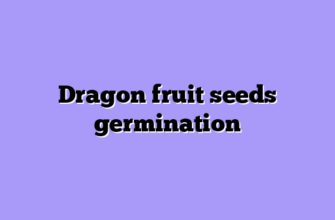Dragon fruit is a tropical fruit that is native to Central and South America. It is a popular fruit in many parts of the world, and is known for its unique appearance and sweet taste. Growing dragon fruit requires specific conditions, such as warm temperatures, plenty of sunlight, and well-drained soil.
With the right conditions, dragon fruit can be a rewarding and delicious addition to any garden.
The Ideal Climate for Growing Dragon Fruit
Dragon fruit, also known as pitaya, is a tropical fruit native to Central and South America. It is a popular ingredient in many dishes and is known for its sweet, juicy flavor. Growing dragon fruit requires a warm, humid climate with plenty of sunlight.
The ideal climate for growing dragon fruit is one with temperatures ranging from 70 to 90 degrees Fahrenheit (21 to 32 degrees Celsius). The plant prefers full sun, but can tolerate some shade. It is important to ensure that the soil is well-draining and that the plant is not exposed to excessive moisture.
Dragon fruit plants require a high level of humidity, so it is important to provide adequate irrigation. The plant should be watered regularly, but not to the point of saturation. It is also important to ensure that the soil is not too dry, as this can cause the plant to become stressed.

Dragon fruit plants are also sensitive to wind, so it is important to provide some shelter from strong winds. A windbreak, such as a fence or wall, can help protect the plant from strong winds.
Dragon fruit plants require a long growing season, so it is important to choose a location with a long growing season. In the United States, the best climates for growing dragon fruit are in the southern states, such as Florida, Texas, and California.
In conclusion, dragon fruit plants require a warm, humid climate with plenty of sunlight and adequate irrigation. It is important to protect the plant from cold temperatures and strong winds, and to choose a location with a long growing season. With the right conditions, dragon fruit can be a rewarding and delicious addition to any garden.
How to Maximize Soil Quality for Dragon Fruit
To ensure that your dragon fruit plants are able to thrive, it is important to maximize the quality of the soil in which they are planted. Here are some tips for doing so:
- Test the soil: Before planting your dragon fruit, it is important to test the soil to determine its pH level and nutrient content. This will help you determine what amendments, if any, need to be added to the soil to ensure that it is suitable for dragon fruit.
- Add organic matter: Adding organic matter such as compost or manure to the soil will help improve its structure and nutrient content. This will help ensure that the soil is able to retain moisture and provide the necessary nutrients for the dragon fruit plants to thrive.
- Improve drainage: Dragon fruit plants prefer well-draining soil. If the soil is too compact or clay-like, it may be necessary to add sand or other materials to improve drainage.
- Mulch: Adding a layer of mulch to the soil will help retain moisture and reduce the need for frequent watering. It will also help prevent weeds from taking over the soil.
By following these tips, you can ensure that your dragon fruit plants have the best possible soil in which to grow. With the right soil, your dragon fruit plants will be able to thrive and produce delicious fruit for years to come.
The Benefits of Using Organic Fertilizers for Dragon Fruit
Organic fertilizers are becoming increasingly popular among dragon fruit growers due to their numerous benefits. Organic fertilizers are derived from natural sources such as animal manure, compost, and plant matter, and are free from synthetic chemicals. They are an excellent choice for dragon fruit growers as they provide essential nutrients to the soil and help to promote healthy plant growth.
Organic fertilizers are slow-release, meaning that they release their nutrients gradually over time. This helps to ensure that the dragon fruit plants receive a steady supply of nutrients, rather than a large dose all at once. This helps to reduce the risk of nutrient burn, which can occur when too much fertilizer is applied at once. Organic fertilizers also help to improve the soil structure, which can help to improve drainage and aeration. This can help to reduce the risk of root rot and other soil-borne diseases.
Organic fertilizers are also beneficial for the environment. They are free from synthetic chemicals, which can be harmful to the environment if they are not used correctly. Organic fertilizers also help to improve the soil’s microbial activity, which can help to reduce the need for chemical pesticides and herbicides.
Organic fertilizers are also cost-effective. They are often cheaper than synthetic fertilizers, and they can be used for multiple seasons. This means that dragon fruit growers can save money in the long run by using organic fertilizers.
Overall, organic fertilizers are an excellent choice for dragon fruit growers. They provide essential nutrients to the soil, help to improve the soil structure, and are beneficial for the environment. They are also cost-effective and can be used for multiple seasons. For these reasons, organic fertilizers are an excellent choice for dragon fruit growers.
How to Manage Pests and Diseases in Dragon Fruit Plantations
Like any other crop, dragon fruit plantations are susceptible to pests and diseases. To ensure a successful harvest, it is important to take the necessary steps to manage pests and diseases in dragon fruit plantations.
The first step in managing pests and diseases in dragon fruit plantations is to identify the pests and diseases that are present. Common pests include mealybugs, scale insects, and whiteflies. Common diseases include anthracnose, root rot, and powdery mildew. Once the pests and diseases have been identified, it is important to take the necessary steps to control them.

It is also important to monitor the dragon fruit plantation regularly for signs of pests and diseases. This can be done by inspecting the plants for signs of damage, such as wilting leaves or discolored fruit. If pests or diseases are found, it is important to take the necessary steps to control them as soon as possible.
Finally, it is important to practice good hygiene in the dragon fruit plantation. This includes removing any dead or diseased plants, as well as any debris or weeds that may harbor pests or diseases. It is also important to avoid overcrowding the plants, as this can lead to an increase in pest and disease populations.
By following these steps, it is possible to effectively manage pests and diseases in dragon fruit plantations. This will help ensure a successful harvest and a healthy crop.
The Pros and Cons of Growing Dragon Fruit in Containers
Growing dragon fruit in containers can be a great way to enjoy the exotic and delicious fruit without having to dedicate a large area of land to its cultivation. However, there are both advantages and disadvantages to consider before deciding to grow dragon fruit in containers.
Pros
One of the main advantages of growing dragon fruit in containers is that it is much easier to control the environment in which the plant is growing. Containers can be moved to areas with more or less sunlight, and the soil can be amended to provide the optimal conditions for the plant. Additionally, containers can be used to protect the plant from extreme weather conditions, such as heavy rain or strong winds.
Another benefit of growing dragon fruit in containers is that it is much easier to monitor the health of the plant. Containers are easier to inspect for signs of disease or pests, and it is easier to ensure that the plant is receiving the right amount of water and nutrients.
Cons
One of the main drawbacks of growing dragon fruit in containers is that it requires more frequent watering and fertilizing than if the plant were grown in the ground. Containers tend to dry out more quickly than the ground, so it is important to keep an eye on the moisture levels in the soil. Additionally, containers can become too hot in the summer, so it is important to provide adequate shade and ventilation.
Another potential issue with growing dragon fruit in containers is that the plant can become root-bound if the container is too small. This can lead to stunted growth and decreased yields, so it is important to choose a container that is large enough to accommodate the plant’s root system.
In conclusion, growing dragon fruit in containers can be a great way to enjoy the exotic and delicious fruit without having to dedicate a large area of land to its cultivation. However, it is important to consider both the advantages and disadvantages before deciding to grow dragon fruit in containers.
Conclusion
In conclusion, dragon fruit requires warm, humid conditions with plenty of sunlight and well-draining soil to thrive. It is important to provide adequate water and fertilizer to ensure healthy growth and fruit production. With the right growing conditions, dragon fruit can be a rewarding and delicious addition to any garden.








